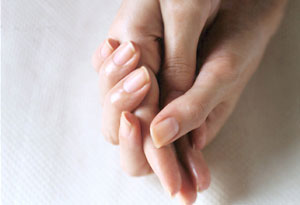The Secret to Beautiful, Line-Free Hands

Photo: Maria Robledo
Are your hands knuckling under? A model and a dermatologist offer health and beauty advice for your gorgeous pincers.
"Roll up your sleeves and plunge both hands into life," wrote the playwright Jean Anouilh, to which we say amen. But here's the thing: As much as your hands are the instruments of a full life, they're also the frequent victims of it. From the loftiest activity (sculpting a work of art) to the most mundane (popping open a can of Diet Coke), almost any portion of your daily routine can lead to manual misfortune. Still, broken nails, paper cuts, jagged cuticles, and age spots don't have to be the by-products of going about your business. With a little help from the pros, you can handily avoid the typical pitfalls and repair existing damage. The experts in question: New York–based parts model Ellen Sirot (the Cindy Crawford of hand modeling) and Deborah Sarnoff, MD, associate clinical professor of dermatology at New York University.
Sirot and Sarnoff suggest the same basic regimen, and it starts with a cardinal rule: Never venture into daylight without an SPF of at least 15 on your hands, where the skin is particularly delicate and vulnerable to premature aging. "Your hands can look up to ten years older than your face," says Sarnoff, "especially if—like many women—you've been vigilant about keeping your face free of sun damage without giving much thought to your hands."
Sunscreens, skin-smoothing acids, and other damage-fighting ingredients that have long been staples of the facial care industry are now turning up in hand lotions. "If cold weather makes your hands dry and flaky, try using a lotion with a poly- or alpha hydroxy acid to lightly exfoliate the skin, and a hand cream with kinetin to even out skin tone and texture," says Sarnoff. To fight dry winter hands, Sarnoff also recommends washing your hands with a mild, nondrying facial cleanser rather than lathering up with your usual bar soap. "Once a week I use a mild exfoliant on my hands," says Sarnoff. "I like Kiehl's milk, honey, and almond scrub."
Avoid the infection-inviting ritual of cutting your cuticles; push them back instead. "I use a washcloth to push mine back in the shower when they're moist and pliable," Sirot says. She also douses them with vitamin E oil every night. But according to Sarnoff, any oil will do—the idea is to keep them moisturized while you sleep.
"I wear elbow-length gloves when I'm not modeling to avoid sun exposure, nicks, paper cuts, and other side effects of the daily grind," says Sirot, whose livelihood depends on perfect fingers and nails. But if wearing opera gloves for all occasions won't work for you (just a hunch), try to be more mindful when using your hands. Instead of pulling that staple off with your fingernails, use a staple remover. A letter opener could save you from getting a paper cut from the edge of an envelope. And don't take out your nervousness on your nails—mindlessly drumming them on your desk or, even worse, biting them. Being even minimally aware of your hands as you reach for something, open and close a jar, or flick a switch can help protect them.
To ease the tension that accumulates in your hands from activities like typing or washing dishes, Sirot suggests that you regularly pause during the activity and rotate your wrists and massage your fingers and palms.
Some flaws are not just cosmetic. As Sarnoff points out, irregularities in your nails may suggest medical problems: Spooning (the medical term for nail tips that curve slightly upward) can be a sign of anemia. Yellowish nails, though usually the result of consistent use of red polish, could indicate liver disease. White marks are often a sign of trauma and can result from the overzealous use of metal files and cuticle sticks. And although the medical establishment doesn't know why, tiny depressions in the nails may foretell alopecia (hair loss). "Thin, brittle nails can signal overexposure to water. Doctors commonly experience this problem because we wash our hands so frequently," says Sarnoff. "But brittle nails can also come from the formaldehyde in nail polish or the acetone in polish remover." And ridged nails are often symptomatic of moisture-deprived cuticles. If you're experiencing any of the above, see your dermatologist.
Abbie Kozolchyk is a New York City freelance writer.
Hand yourself over to our experts:



